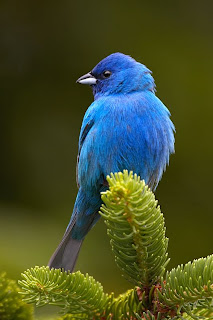
Sorry for posting late this week but I had a busy weekend. As you can see from the title and picture the blue jay was voted bird of the week. I'll tally those not chose and add them to next weeks voting. Right now the rose-breasted grosbeak is in the lead.
The blue jay is a larger (12") bright light blue and white bird, with a crest that moves up and down at will and black collar and necklace. They have a white face and gray belly. They have single white wing bars on blue wings. They also have black spots and a white tip on a blue tail. The female looks the same as the male and the juvenile is the same as the adult but more dull in color.
Blue jays build a cup style nest that both male and female construct. The nest consist of twigs, bark, leaves and man made objects. It's then lined with fine rootlets placed in a tree. They have between 1-2 broods per year and lay 4-5 eggs which are green to blue with brown markings. The incubation period last 16-18 days and the female incubates. The fledgling stage is 17-21 days and both parents feed the young. You can always tell if your near a nest because blue jays will not hesitate to sweep down on even humans if your close. I remember getting dive bombed walking to and from school when I was younger.
Their diet consist of insects, fruit, carrion, seeds, nuts and cracked corn. I found that one of their favorites is whole peanuts in the shell. They will come to a feeder, grab the peanut then go work or store it in a tree. During the winter they were very vocal if I did not have peanuts in the feeder. I always put them out the night before and by noon they were letting me know they were out. If you decide to feed them peanuts in the shell, remember to get them with no salt. Salt will kill birds. There was a story on the news a few years ago about a lady finding dead birds in her yard. They come to find out she was feeding them Saltine cracker. So when feeding peanuts of any kind remember NO SALT.
As far as migration is concerned, they are a non-migrator to partial migrator. By partial migrator I mean they will migrate and move around to find abundant food. It took me a couple years to get the blue jays visiting in my back yard. Once they were there I kept them by keeping them happy with peanuts.
Blue jays are a very intelligent bird that is good at problem solving, gathering food and communicating more than other birds. If you have them around I'm sure you've heard their shrill scream like a hawk to scatter birds at a feeder. They have been known to eat eggs or young birds from the nest of other birds. They can also act as an alarm in the woods letting out a loud scream when they spot intruders. I've seen that act to many times while deer hunting. The are also one of a few birds to store food as I mention with the peanuts earlier. A final interesting fact is they don't really have blue pigment, rather refracted sunlight cast a blue light.
If your not getting blue jays in your yard yet you make want to give it a shot. Yes they are noisy and yes they clear birds off a feeder when they want in. But the beauty and color they bring far out ways some of their bad habits. During the winter nothing look better than fresh falling snow and to have both blue jays and cardinals in your back yard at the same time. The blue and red against the white snow is enough to warm anyones cold winter soul.
Until next week keep the birds fed and watered and also to remember to vote in the side poll for next weeks bird. Have a great week.





